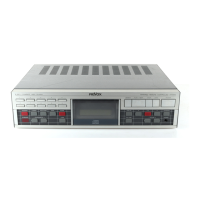?rr-S-£
:
JL\Fi FI&/OX B225 ! SECTION 4/12*
4.3.5 Cross talk
- Adjust for maximum level with VOLUME + key,
- Reference = CAL TONE 1000 Hz)
- Measure both outputs across a 30 kHz low-pass:
Play track 8 for measuring cross talk R -> L
Play track 4 for measuring cross talk L -> R
- The cross talk attenuation should be at least 90 dB.
4.3.6 Signal-to-noise ratio, linear
- Maximum volume, reference = CAL TONE 1000 Hz.
- Play track 18 and measure the outputs FIXED and
VARIABLE via a 30 kHz low-pass.
- The measured value should be higher than -96 dB,
4.3.7 Signal-to-noise ratio, weighted
- Maximum volume, reference = CAL TONE 1000 Hz.
- Play track 18 and measure the outputs FIXED and
VARIABLE via an A filter.
- The measured value should be higher than 100 dB,
4.3.8 Phase linearity
- Connect oscilloscope to one of the outputs.
- Play track 20 and visually assess the square-wave
signals at 100 Hz, 400 Hz, 1002 Hz, and 5512 Hz.
The curve should be shaped symmetrically (see
Fig.
4.17).
, .
4.4 Listening test with reference CD (part No.
4
6241)
The reference CD simulates the following errors for
checking the error correction system:
- Information gaps with a length of 400 to 900 pm (tracks
5 through 9)
- Black dots from 300 to 800 micrometers
(tracks 1*1 through track 17)
- Simulated fingerprint (tracks 18 and 19)
The simulated defects should not cause any drop-outs
(reproduction
gaps).
If drop-outs become audible, this
can for example be caused by the following errors:
- IC13 (SAA 7010,
demodulator),
clock regeneration
with PLL defect.
- HFL an DO detector defective.

